Case Study: Employee Turnover in Transport and Logistics at Lussotrans
VerifiedAdded on 2023/01/04
|78
|24185
|66
Case Study
AI Summary
This dissertation presents a case study focused on Lussotrans SRL, a transport and logistics company, examining the causes, effects, and impacts of high employee turnover. The study delves into the company's background, operational structure, and the significance of employee management for economic development. It explores the research aim, objectives, and questions, along with a comprehensive literature review utilizing secondary sources. The methodology encompasses research philosophy, strategy, and approach, including data collection methods like interviews and questionnaires, and analysis techniques such as frequency distribution and thematic analysis. The findings highlight the factors contributing to low motivation, the effects of motivation on employee turnover, and the importance of staff retention strategies. The study concludes with recommendations for improving employee management and proposes areas for future research, along with a personal development plan for the researcher.
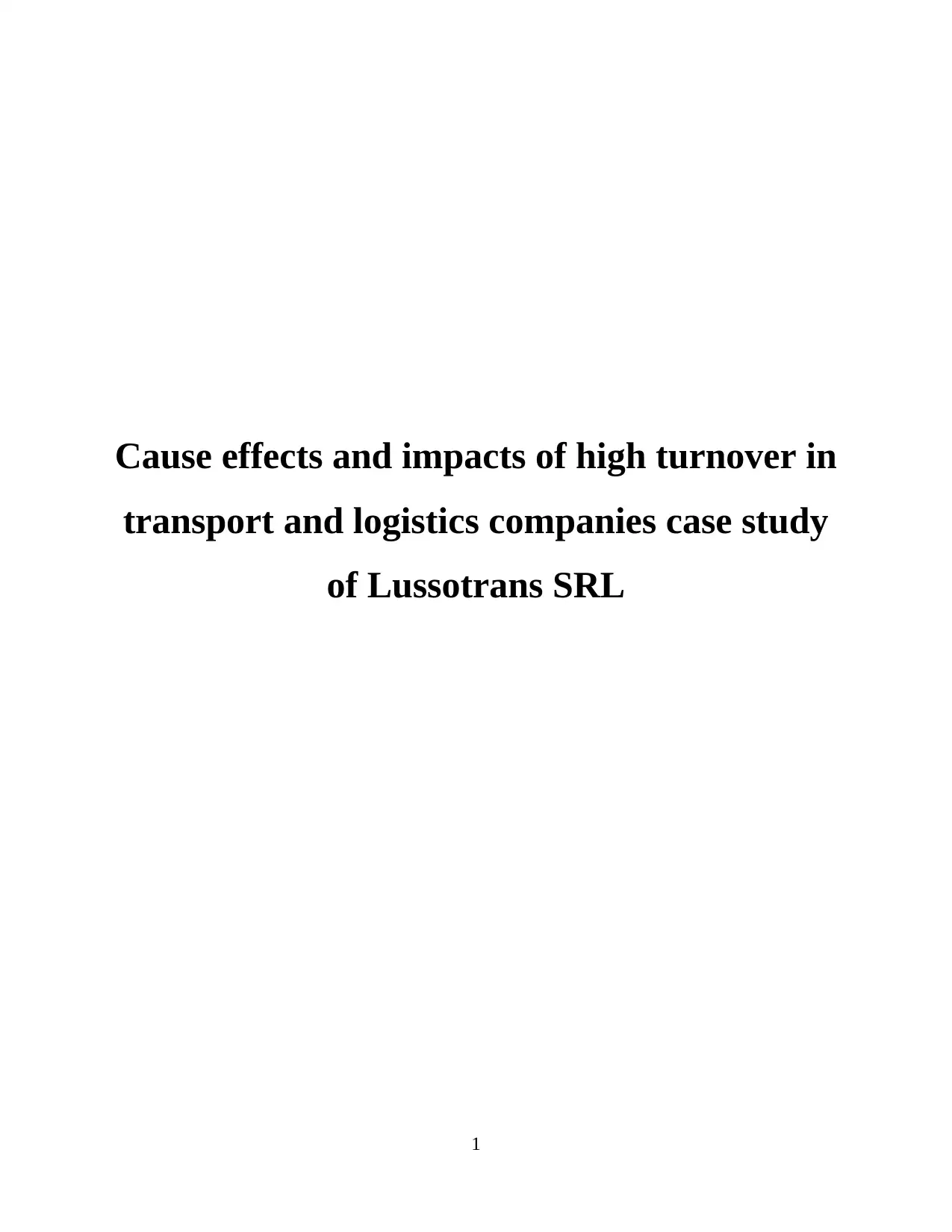
Cause effects and impacts of high turnover in
transport and logistics companies case study
of Lussotrans SRL
1
transport and logistics companies case study
of Lussotrans SRL
1
Paraphrase This Document
Need a fresh take? Get an instant paraphrase of this document with our AI Paraphraser
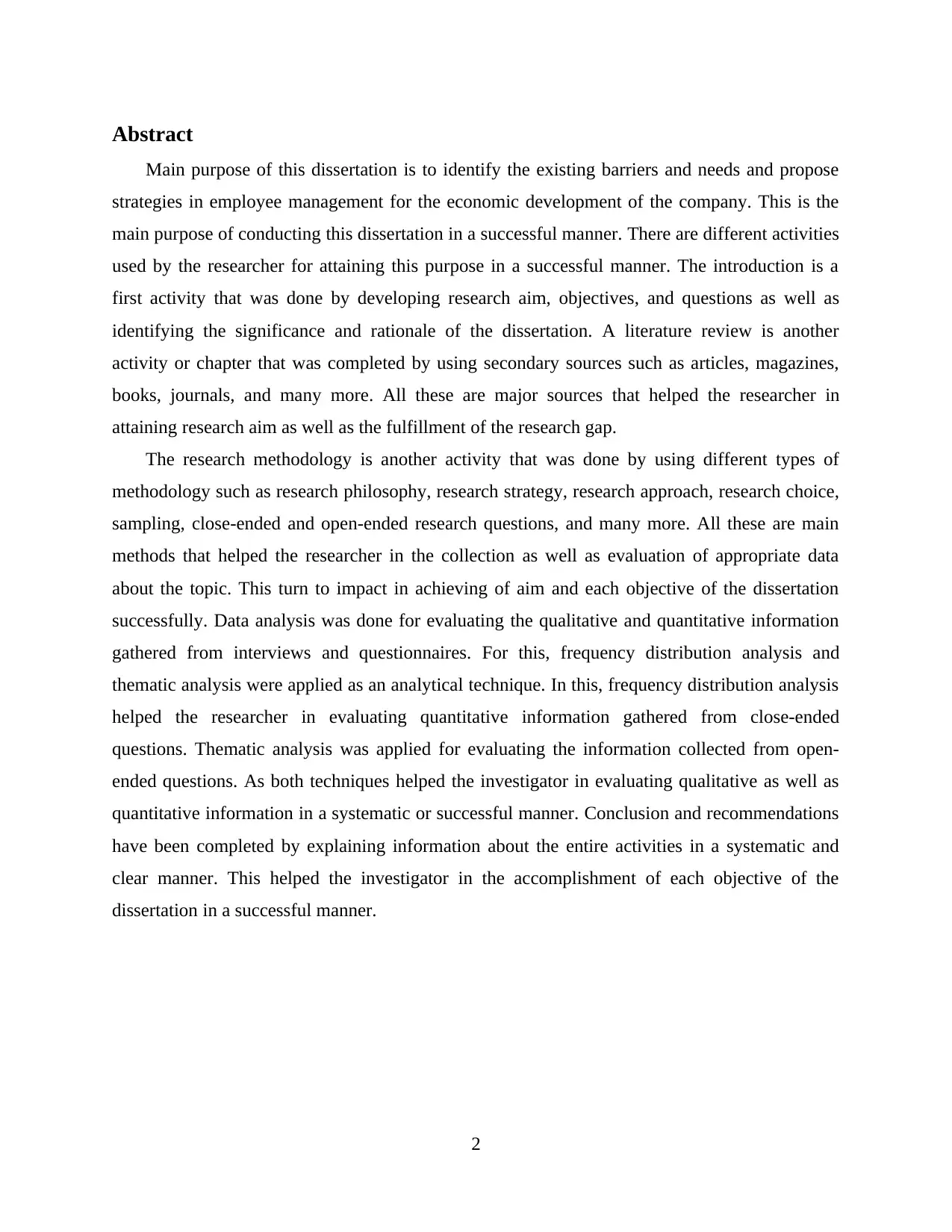
Abstract
Main purpose of this dissertation is to identify the existing barriers and needs and propose
strategies in employee management for the economic development of the company. This is the
main purpose of conducting this dissertation in a successful manner. There are different activities
used by the researcher for attaining this purpose in a successful manner. The introduction is a
first activity that was done by developing research aim, objectives, and questions as well as
identifying the significance and rationale of the dissertation. A literature review is another
activity or chapter that was completed by using secondary sources such as articles, magazines,
books, journals, and many more. All these are major sources that helped the researcher in
attaining research aim as well as the fulfillment of the research gap.
The research methodology is another activity that was done by using different types of
methodology such as research philosophy, research strategy, research approach, research choice,
sampling, close-ended and open-ended research questions, and many more. All these are main
methods that helped the researcher in the collection as well as evaluation of appropriate data
about the topic. This turn to impact in achieving of aim and each objective of the dissertation
successfully. Data analysis was done for evaluating the qualitative and quantitative information
gathered from interviews and questionnaires. For this, frequency distribution analysis and
thematic analysis were applied as an analytical technique. In this, frequency distribution analysis
helped the researcher in evaluating quantitative information gathered from close-ended
questions. Thematic analysis was applied for evaluating the information collected from open-
ended questions. As both techniques helped the investigator in evaluating qualitative as well as
quantitative information in a systematic or successful manner. Conclusion and recommendations
have been completed by explaining information about the entire activities in a systematic and
clear manner. This helped the investigator in the accomplishment of each objective of the
dissertation in a successful manner.
2
Main purpose of this dissertation is to identify the existing barriers and needs and propose
strategies in employee management for the economic development of the company. This is the
main purpose of conducting this dissertation in a successful manner. There are different activities
used by the researcher for attaining this purpose in a successful manner. The introduction is a
first activity that was done by developing research aim, objectives, and questions as well as
identifying the significance and rationale of the dissertation. A literature review is another
activity or chapter that was completed by using secondary sources such as articles, magazines,
books, journals, and many more. All these are major sources that helped the researcher in
attaining research aim as well as the fulfillment of the research gap.
The research methodology is another activity that was done by using different types of
methodology such as research philosophy, research strategy, research approach, research choice,
sampling, close-ended and open-ended research questions, and many more. All these are main
methods that helped the researcher in the collection as well as evaluation of appropriate data
about the topic. This turn to impact in achieving of aim and each objective of the dissertation
successfully. Data analysis was done for evaluating the qualitative and quantitative information
gathered from interviews and questionnaires. For this, frequency distribution analysis and
thematic analysis were applied as an analytical technique. In this, frequency distribution analysis
helped the researcher in evaluating quantitative information gathered from close-ended
questions. Thematic analysis was applied for evaluating the information collected from open-
ended questions. As both techniques helped the investigator in evaluating qualitative as well as
quantitative information in a systematic or successful manner. Conclusion and recommendations
have been completed by explaining information about the entire activities in a systematic and
clear manner. This helped the investigator in the accomplishment of each objective of the
dissertation in a successful manner.
2
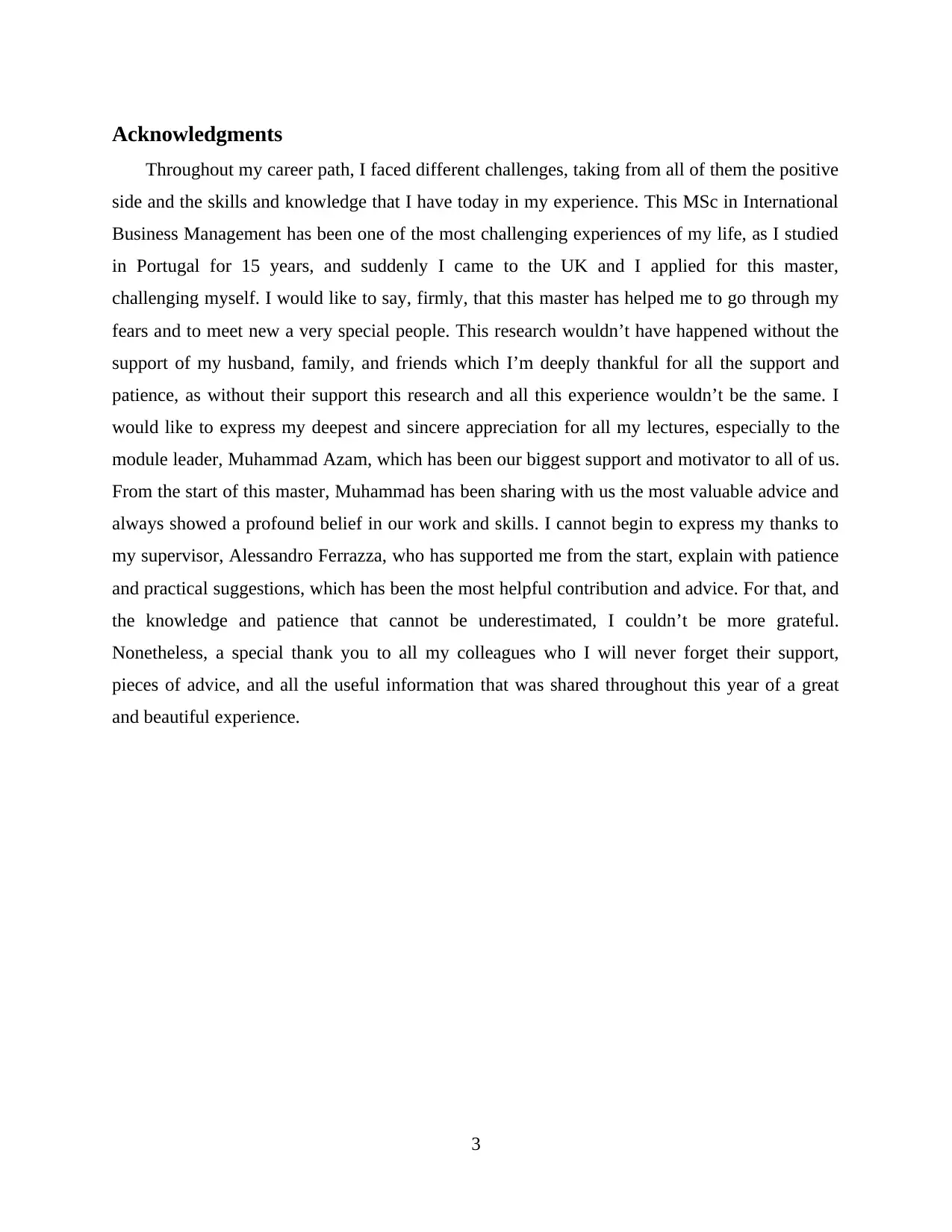
Acknowledgments
Throughout my career path, I faced different challenges, taking from all of them the positive
side and the skills and knowledge that I have today in my experience. This MSc in International
Business Management has been one of the most challenging experiences of my life, as I studied
in Portugal for 15 years, and suddenly I came to the UK and I applied for this master,
challenging myself. I would like to say, firmly, that this master has helped me to go through my
fears and to meet new a very special people. This research wouldn’t have happened without the
support of my husband, family, and friends which I’m deeply thankful for all the support and
patience, as without their support this research and all this experience wouldn’t be the same. I
would like to express my deepest and sincere appreciation for all my lectures, especially to the
module leader, Muhammad Azam, which has been our biggest support and motivator to all of us.
From the start of this master, Muhammad has been sharing with us the most valuable advice and
always showed a profound belief in our work and skills. I cannot begin to express my thanks to
my supervisor, Alessandro Ferrazza, who has supported me from the start, explain with patience
and practical suggestions, which has been the most helpful contribution and advice. For that, and
the knowledge and patience that cannot be underestimated, I couldn’t be more grateful.
Nonetheless, a special thank you to all my colleagues who I will never forget their support,
pieces of advice, and all the useful information that was shared throughout this year of a great
and beautiful experience.
3
Throughout my career path, I faced different challenges, taking from all of them the positive
side and the skills and knowledge that I have today in my experience. This MSc in International
Business Management has been one of the most challenging experiences of my life, as I studied
in Portugal for 15 years, and suddenly I came to the UK and I applied for this master,
challenging myself. I would like to say, firmly, that this master has helped me to go through my
fears and to meet new a very special people. This research wouldn’t have happened without the
support of my husband, family, and friends which I’m deeply thankful for all the support and
patience, as without their support this research and all this experience wouldn’t be the same. I
would like to express my deepest and sincere appreciation for all my lectures, especially to the
module leader, Muhammad Azam, which has been our biggest support and motivator to all of us.
From the start of this master, Muhammad has been sharing with us the most valuable advice and
always showed a profound belief in our work and skills. I cannot begin to express my thanks to
my supervisor, Alessandro Ferrazza, who has supported me from the start, explain with patience
and practical suggestions, which has been the most helpful contribution and advice. For that, and
the knowledge and patience that cannot be underestimated, I couldn’t be more grateful.
Nonetheless, a special thank you to all my colleagues who I will never forget their support,
pieces of advice, and all the useful information that was shared throughout this year of a great
and beautiful experience.
3
⊘ This is a preview!⊘
Do you want full access?
Subscribe today to unlock all pages.

Trusted by 1+ million students worldwide
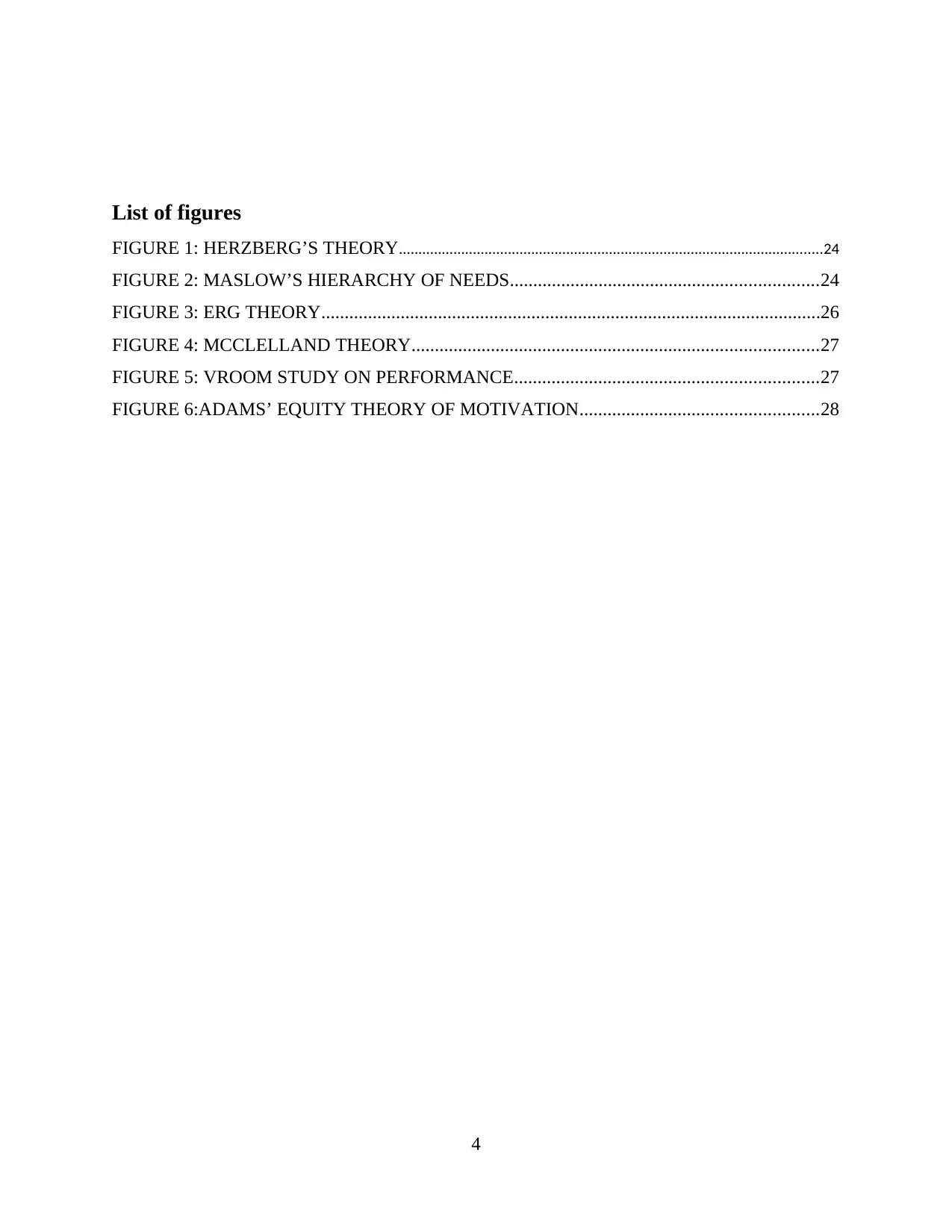
List of figures
FIGURE 1: HERZBERG’S THEORY.............................................................................................................24
FIGURE 2: MASLOW’S HIERARCHY OF NEEDS..................................................................24
FIGURE 3: ERG THEORY...........................................................................................................26
FIGURE 4: MCCLELLAND THEORY.......................................................................................27
FIGURE 5: VROOM STUDY ON PERFORMANCE.................................................................27
FIGURE 6:ADAMS’ EQUITY THEORY OF MOTIVATION...................................................28
4
FIGURE 1: HERZBERG’S THEORY.............................................................................................................24
FIGURE 2: MASLOW’S HIERARCHY OF NEEDS..................................................................24
FIGURE 3: ERG THEORY...........................................................................................................26
FIGURE 4: MCCLELLAND THEORY.......................................................................................27
FIGURE 5: VROOM STUDY ON PERFORMANCE.................................................................27
FIGURE 6:ADAMS’ EQUITY THEORY OF MOTIVATION...................................................28
4
Paraphrase This Document
Need a fresh take? Get an instant paraphrase of this document with our AI Paraphraser
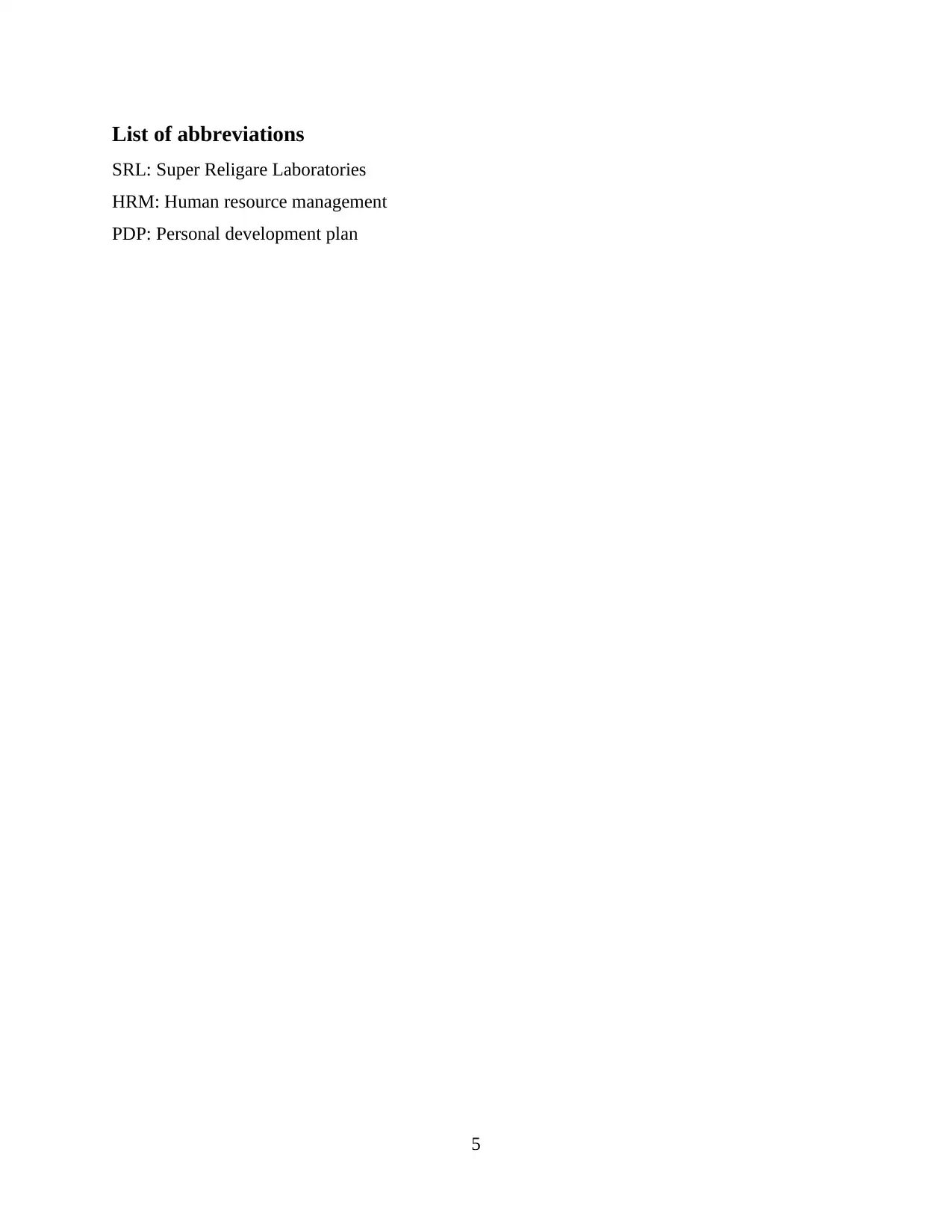
List of abbreviations
SRL: Super Religare Laboratories
HRM: Human resource management
PDP: Personal development plan
5
SRL: Super Religare Laboratories
HRM: Human resource management
PDP: Personal development plan
5
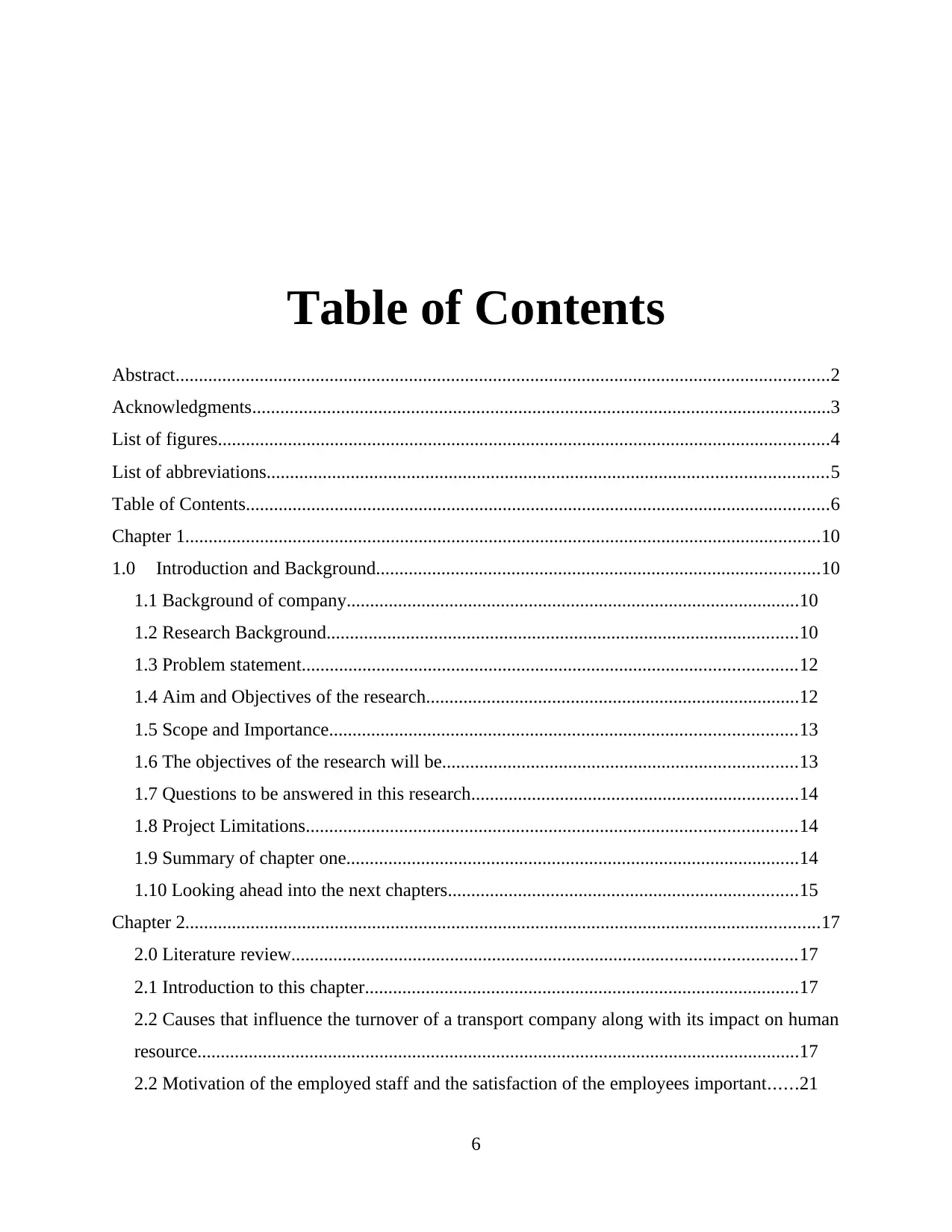
Table of Contents
Abstract............................................................................................................................................2
Acknowledgments............................................................................................................................3
List of figures...................................................................................................................................4
List of abbreviations........................................................................................................................5
Table of Contents.............................................................................................................................6
Chapter 1........................................................................................................................................10
1.0 Introduction and Background...............................................................................................10
1.1 Background of company.................................................................................................10
1.2 Research Background.....................................................................................................10
1.3 Problem statement..........................................................................................................12
1.4 Aim and Objectives of the research................................................................................12
1.5 Scope and Importance....................................................................................................13
1.6 The objectives of the research will be............................................................................13
1.7 Questions to be answered in this research......................................................................14
1.8 Project Limitations.........................................................................................................14
1.9 Summary of chapter one.................................................................................................14
1.10 Looking ahead into the next chapters...........................................................................15
Chapter 2........................................................................................................................................17
2.0 Literature review............................................................................................................17
2.1 Introduction to this chapter.............................................................................................17
2.2 Causes that influence the turnover of a transport company along with its impact on human
resource.................................................................................................................................17
2.2 Motivation of the employed staff and the satisfaction of the employees important......21
6
Abstract............................................................................................................................................2
Acknowledgments............................................................................................................................3
List of figures...................................................................................................................................4
List of abbreviations........................................................................................................................5
Table of Contents.............................................................................................................................6
Chapter 1........................................................................................................................................10
1.0 Introduction and Background...............................................................................................10
1.1 Background of company.................................................................................................10
1.2 Research Background.....................................................................................................10
1.3 Problem statement..........................................................................................................12
1.4 Aim and Objectives of the research................................................................................12
1.5 Scope and Importance....................................................................................................13
1.6 The objectives of the research will be............................................................................13
1.7 Questions to be answered in this research......................................................................14
1.8 Project Limitations.........................................................................................................14
1.9 Summary of chapter one.................................................................................................14
1.10 Looking ahead into the next chapters...........................................................................15
Chapter 2........................................................................................................................................17
2.0 Literature review............................................................................................................17
2.1 Introduction to this chapter.............................................................................................17
2.2 Causes that influence the turnover of a transport company along with its impact on human
resource.................................................................................................................................17
2.2 Motivation of the employed staff and the satisfaction of the employees important......21
6
⊘ This is a preview!⊘
Do you want full access?
Subscribe today to unlock all pages.

Trusted by 1+ million students worldwide
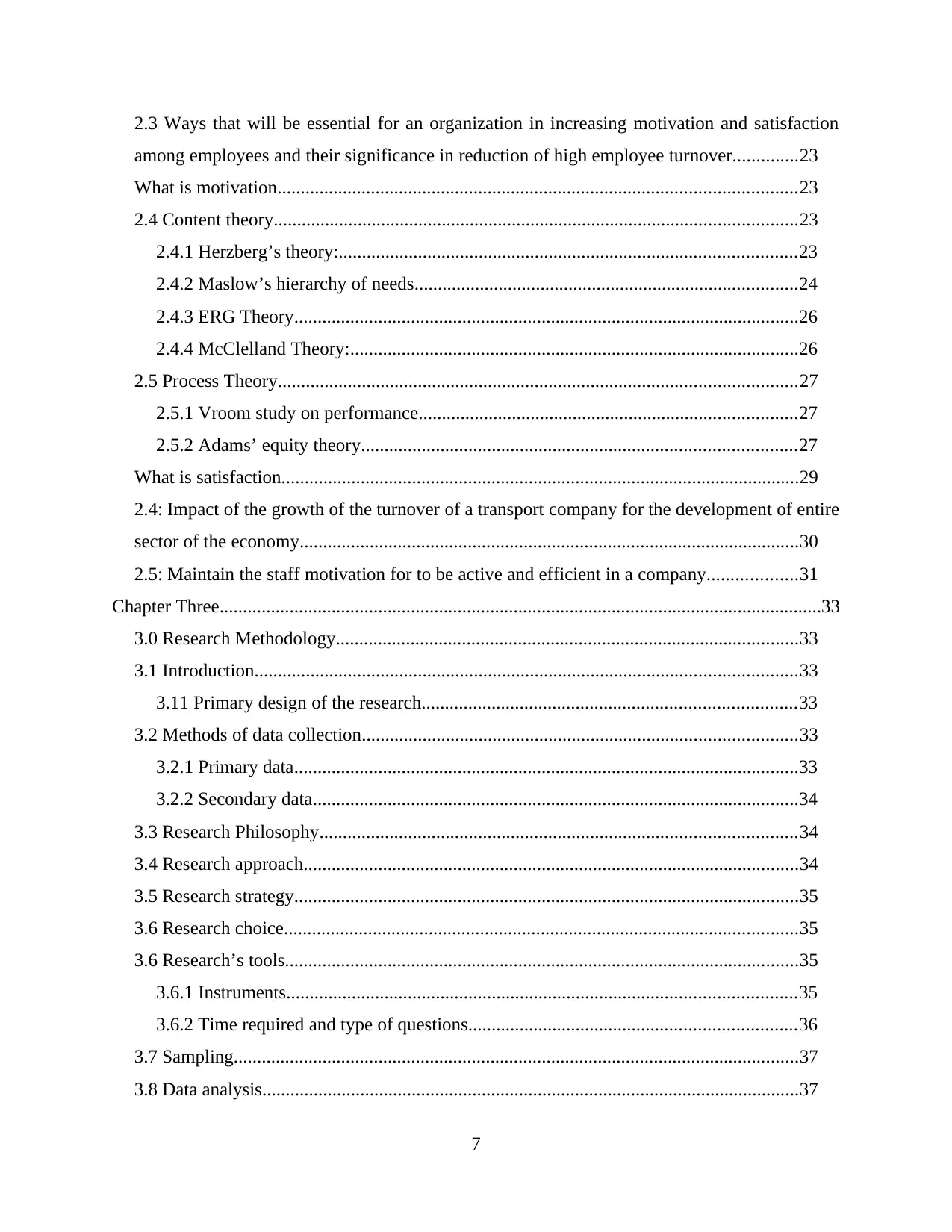
2.3 Ways that will be essential for an organization in increasing motivation and satisfaction
among employees and their significance in reduction of high employee turnover..............23
What is motivation...............................................................................................................23
2.4 Content theory................................................................................................................23
2.4.1 Herzberg’s theory:..................................................................................................23
2.4.2 Maslow’s hierarchy of needs..................................................................................24
2.4.3 ERG Theory............................................................................................................26
2.4.4 McClelland Theory:................................................................................................26
2.5 Process Theory...............................................................................................................27
2.5.1 Vroom study on performance.................................................................................27
2.5.2 Adams’ equity theory.............................................................................................27
What is satisfaction...............................................................................................................29
2.4: Impact of the growth of the turnover of a transport company for the development of entire
sector of the economy...........................................................................................................30
2.5: Maintain the staff motivation for to be active and efficient in a company...................31
Chapter Three.................................................................................................................................33
3.0 Research Methodology...................................................................................................33
3.1 Introduction....................................................................................................................33
3.11 Primary design of the research................................................................................33
3.2 Methods of data collection.............................................................................................33
3.2.1 Primary data............................................................................................................33
3.2.2 Secondary data........................................................................................................34
3.3 Research Philosophy......................................................................................................34
3.4 Research approach..........................................................................................................34
3.5 Research strategy............................................................................................................35
3.6 Research choice..............................................................................................................35
3.6 Research’s tools..............................................................................................................35
3.6.1 Instruments.............................................................................................................35
3.6.2 Time required and type of questions......................................................................36
3.7 Sampling.........................................................................................................................37
3.8 Data analysis...................................................................................................................37
7
among employees and their significance in reduction of high employee turnover..............23
What is motivation...............................................................................................................23
2.4 Content theory................................................................................................................23
2.4.1 Herzberg’s theory:..................................................................................................23
2.4.2 Maslow’s hierarchy of needs..................................................................................24
2.4.3 ERG Theory............................................................................................................26
2.4.4 McClelland Theory:................................................................................................26
2.5 Process Theory...............................................................................................................27
2.5.1 Vroom study on performance.................................................................................27
2.5.2 Adams’ equity theory.............................................................................................27
What is satisfaction...............................................................................................................29
2.4: Impact of the growth of the turnover of a transport company for the development of entire
sector of the economy...........................................................................................................30
2.5: Maintain the staff motivation for to be active and efficient in a company...................31
Chapter Three.................................................................................................................................33
3.0 Research Methodology...................................................................................................33
3.1 Introduction....................................................................................................................33
3.11 Primary design of the research................................................................................33
3.2 Methods of data collection.............................................................................................33
3.2.1 Primary data............................................................................................................33
3.2.2 Secondary data........................................................................................................34
3.3 Research Philosophy......................................................................................................34
3.4 Research approach..........................................................................................................34
3.5 Research strategy............................................................................................................35
3.6 Research choice..............................................................................................................35
3.6 Research’s tools..............................................................................................................35
3.6.1 Instruments.............................................................................................................35
3.6.2 Time required and type of questions......................................................................36
3.7 Sampling.........................................................................................................................37
3.8 Data analysis...................................................................................................................37
7
Paraphrase This Document
Need a fresh take? Get an instant paraphrase of this document with our AI Paraphraser
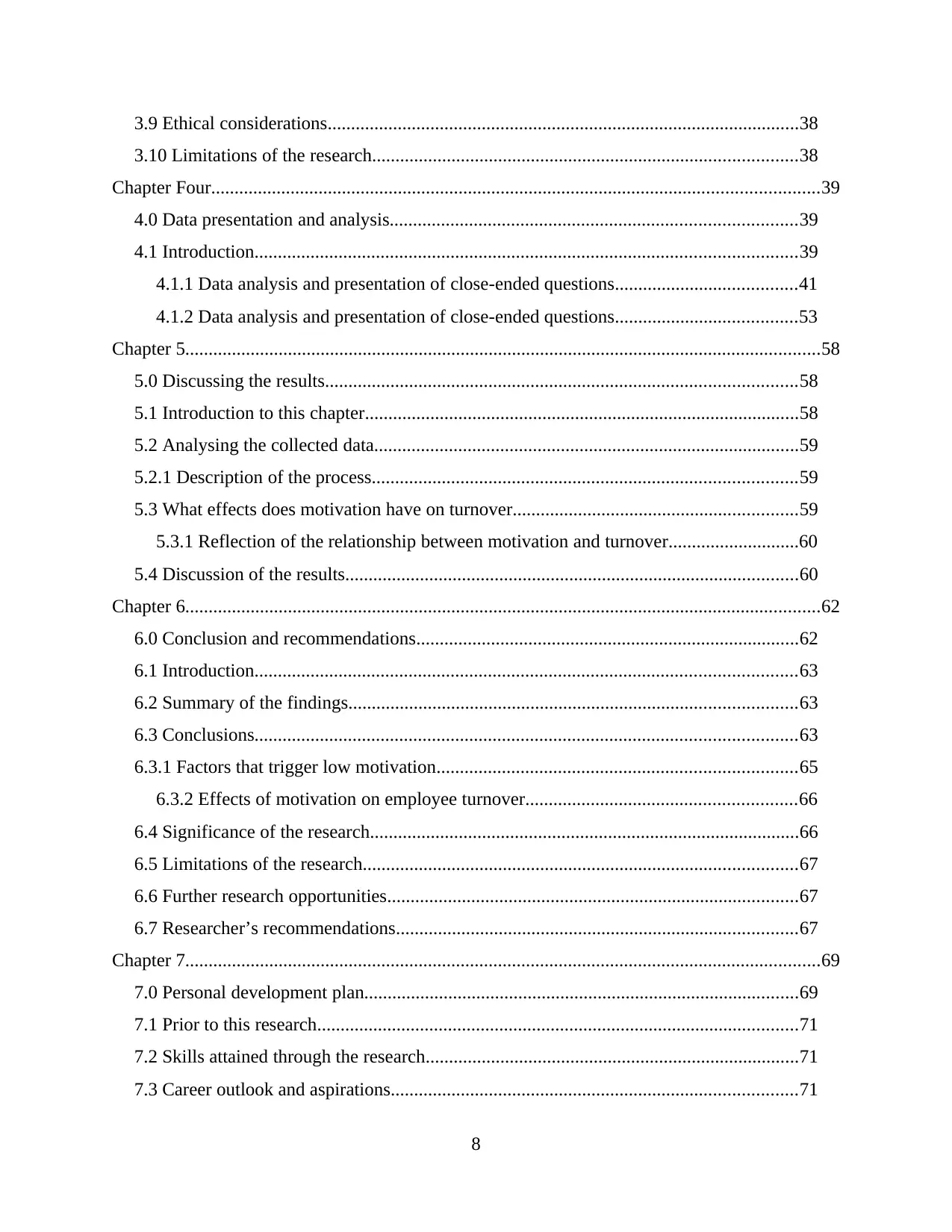
3.9 Ethical considerations.....................................................................................................38
3.10 Limitations of the research...........................................................................................38
Chapter Four..................................................................................................................................39
4.0 Data presentation and analysis.......................................................................................39
4.1 Introduction....................................................................................................................39
4.1.1 Data analysis and presentation of close-ended questions.......................................41
4.1.2 Data analysis and presentation of close-ended questions.......................................53
Chapter 5........................................................................................................................................58
5.0 Discussing the results.....................................................................................................58
5.1 Introduction to this chapter.............................................................................................58
5.2 Analysing the collected data...........................................................................................59
5.2.1 Description of the process...........................................................................................59
5.3 What effects does motivation have on turnover.............................................................59
5.3.1 Reflection of the relationship between motivation and turnover............................60
5.4 Discussion of the results.................................................................................................60
Chapter 6........................................................................................................................................62
6.0 Conclusion and recommendations..................................................................................62
6.1 Introduction....................................................................................................................63
6.2 Summary of the findings................................................................................................63
6.3 Conclusions....................................................................................................................63
6.3.1 Factors that trigger low motivation.............................................................................65
6.3.2 Effects of motivation on employee turnover..........................................................66
6.4 Significance of the research............................................................................................66
6.5 Limitations of the research.............................................................................................67
6.6 Further research opportunities........................................................................................67
6.7 Researcher’s recommendations......................................................................................67
Chapter 7........................................................................................................................................69
7.0 Personal development plan.............................................................................................69
7.1 Prior to this research.......................................................................................................71
7.2 Skills attained through the research................................................................................71
7.3 Career outlook and aspirations.......................................................................................71
8
3.10 Limitations of the research...........................................................................................38
Chapter Four..................................................................................................................................39
4.0 Data presentation and analysis.......................................................................................39
4.1 Introduction....................................................................................................................39
4.1.1 Data analysis and presentation of close-ended questions.......................................41
4.1.2 Data analysis and presentation of close-ended questions.......................................53
Chapter 5........................................................................................................................................58
5.0 Discussing the results.....................................................................................................58
5.1 Introduction to this chapter.............................................................................................58
5.2 Analysing the collected data...........................................................................................59
5.2.1 Description of the process...........................................................................................59
5.3 What effects does motivation have on turnover.............................................................59
5.3.1 Reflection of the relationship between motivation and turnover............................60
5.4 Discussion of the results.................................................................................................60
Chapter 6........................................................................................................................................62
6.0 Conclusion and recommendations..................................................................................62
6.1 Introduction....................................................................................................................63
6.2 Summary of the findings................................................................................................63
6.3 Conclusions....................................................................................................................63
6.3.1 Factors that trigger low motivation.............................................................................65
6.3.2 Effects of motivation on employee turnover..........................................................66
6.4 Significance of the research............................................................................................66
6.5 Limitations of the research.............................................................................................67
6.6 Further research opportunities........................................................................................67
6.7 Researcher’s recommendations......................................................................................67
Chapter 7........................................................................................................................................69
7.0 Personal development plan.............................................................................................69
7.1 Prior to this research.......................................................................................................71
7.2 Skills attained through the research................................................................................71
7.3 Career outlook and aspirations.......................................................................................71
8
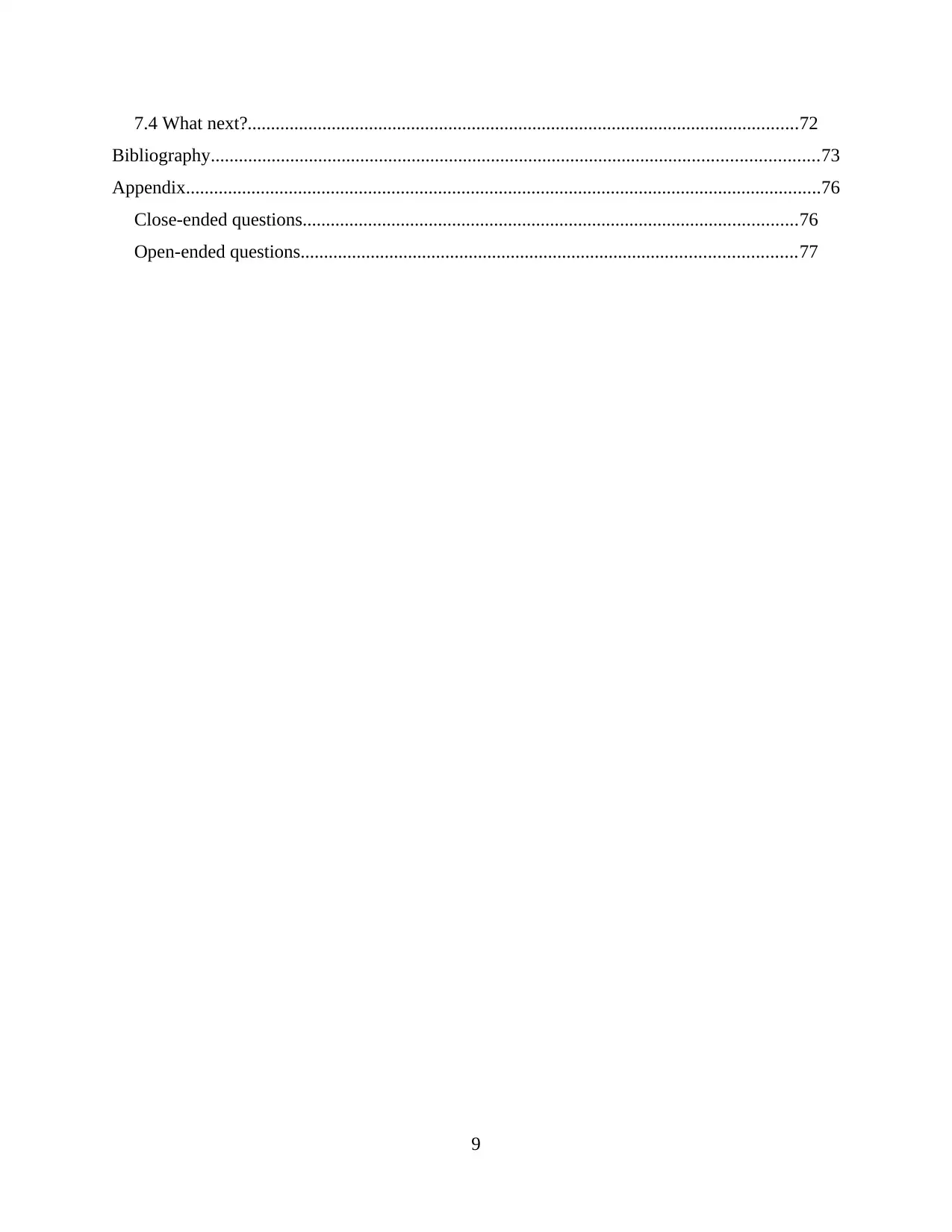
7.4 What next?......................................................................................................................72
Bibliography..................................................................................................................................73
Appendix........................................................................................................................................76
Close-ended questions..........................................................................................................76
Open-ended questions..........................................................................................................77
9
Bibliography..................................................................................................................................73
Appendix........................................................................................................................................76
Close-ended questions..........................................................................................................76
Open-ended questions..........................................................................................................77
9
⊘ This is a preview!⊘
Do you want full access?
Subscribe today to unlock all pages.

Trusted by 1+ million students worldwide
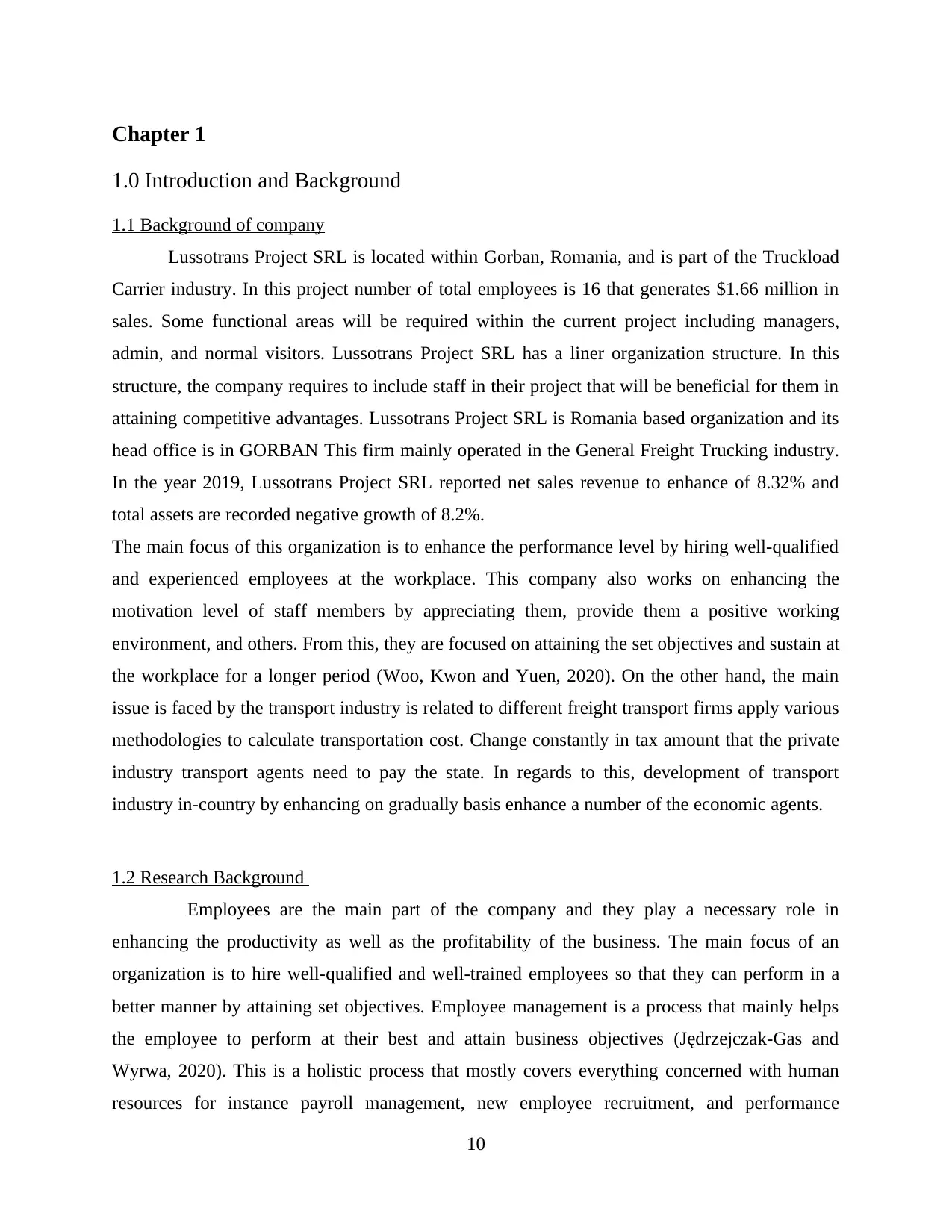
Chapter 1
1.0 Introduction and Background
1.1 Background of company
Lussotrans Project SRL is located within Gorban, Romania, and is part of the Truckload
Carrier industry. In this project number of total employees is 16 that generates $1.66 million in
sales. Some functional areas will be required within the current project including managers,
admin, and normal visitors. Lussotrans Project SRL has a liner organization structure. In this
structure, the company requires to include staff in their project that will be beneficial for them in
attaining competitive advantages. Lussotrans Project SRL is Romania based organization and its
head office is in GORBAN This firm mainly operated in the General Freight Trucking industry.
In the year 2019, Lussotrans Project SRL reported net sales revenue to enhance of 8.32% and
total assets are recorded negative growth of 8.2%.
The main focus of this organization is to enhance the performance level by hiring well-qualified
and experienced employees at the workplace. This company also works on enhancing the
motivation level of staff members by appreciating them, provide them a positive working
environment, and others. From this, they are focused on attaining the set objectives and sustain at
the workplace for a longer period (Woo, Kwon and Yuen, 2020). On the other hand, the main
issue is faced by the transport industry is related to different freight transport firms apply various
methodologies to calculate transportation cost. Change constantly in tax amount that the private
industry transport agents need to pay the state. In regards to this, development of transport
industry in-country by enhancing on gradually basis enhance a number of the economic agents.
1.2 Research Background
Employees are the main part of the company and they play a necessary role in
enhancing the productivity as well as the profitability of the business. The main focus of an
organization is to hire well-qualified and well-trained employees so that they can perform in a
better manner by attaining set objectives. Employee management is a process that mainly helps
the employee to perform at their best and attain business objectives (Jędrzejczak-Gas and
Wyrwa, 2020). This is a holistic process that mostly covers everything concerned with human
resources for instance payroll management, new employee recruitment, and performance
10
1.0 Introduction and Background
1.1 Background of company
Lussotrans Project SRL is located within Gorban, Romania, and is part of the Truckload
Carrier industry. In this project number of total employees is 16 that generates $1.66 million in
sales. Some functional areas will be required within the current project including managers,
admin, and normal visitors. Lussotrans Project SRL has a liner organization structure. In this
structure, the company requires to include staff in their project that will be beneficial for them in
attaining competitive advantages. Lussotrans Project SRL is Romania based organization and its
head office is in GORBAN This firm mainly operated in the General Freight Trucking industry.
In the year 2019, Lussotrans Project SRL reported net sales revenue to enhance of 8.32% and
total assets are recorded negative growth of 8.2%.
The main focus of this organization is to enhance the performance level by hiring well-qualified
and experienced employees at the workplace. This company also works on enhancing the
motivation level of staff members by appreciating them, provide them a positive working
environment, and others. From this, they are focused on attaining the set objectives and sustain at
the workplace for a longer period (Woo, Kwon and Yuen, 2020). On the other hand, the main
issue is faced by the transport industry is related to different freight transport firms apply various
methodologies to calculate transportation cost. Change constantly in tax amount that the private
industry transport agents need to pay the state. In regards to this, development of transport
industry in-country by enhancing on gradually basis enhance a number of the economic agents.
1.2 Research Background
Employees are the main part of the company and they play a necessary role in
enhancing the productivity as well as the profitability of the business. The main focus of an
organization is to hire well-qualified and well-trained employees so that they can perform in a
better manner by attaining set objectives. Employee management is a process that mainly helps
the employee to perform at their best and attain business objectives (Jędrzejczak-Gas and
Wyrwa, 2020). This is a holistic process that mostly covers everything concerned with human
resources for instance payroll management, new employee recruitment, and performance
10
Paraphrase This Document
Need a fresh take? Get an instant paraphrase of this document with our AI Paraphraser
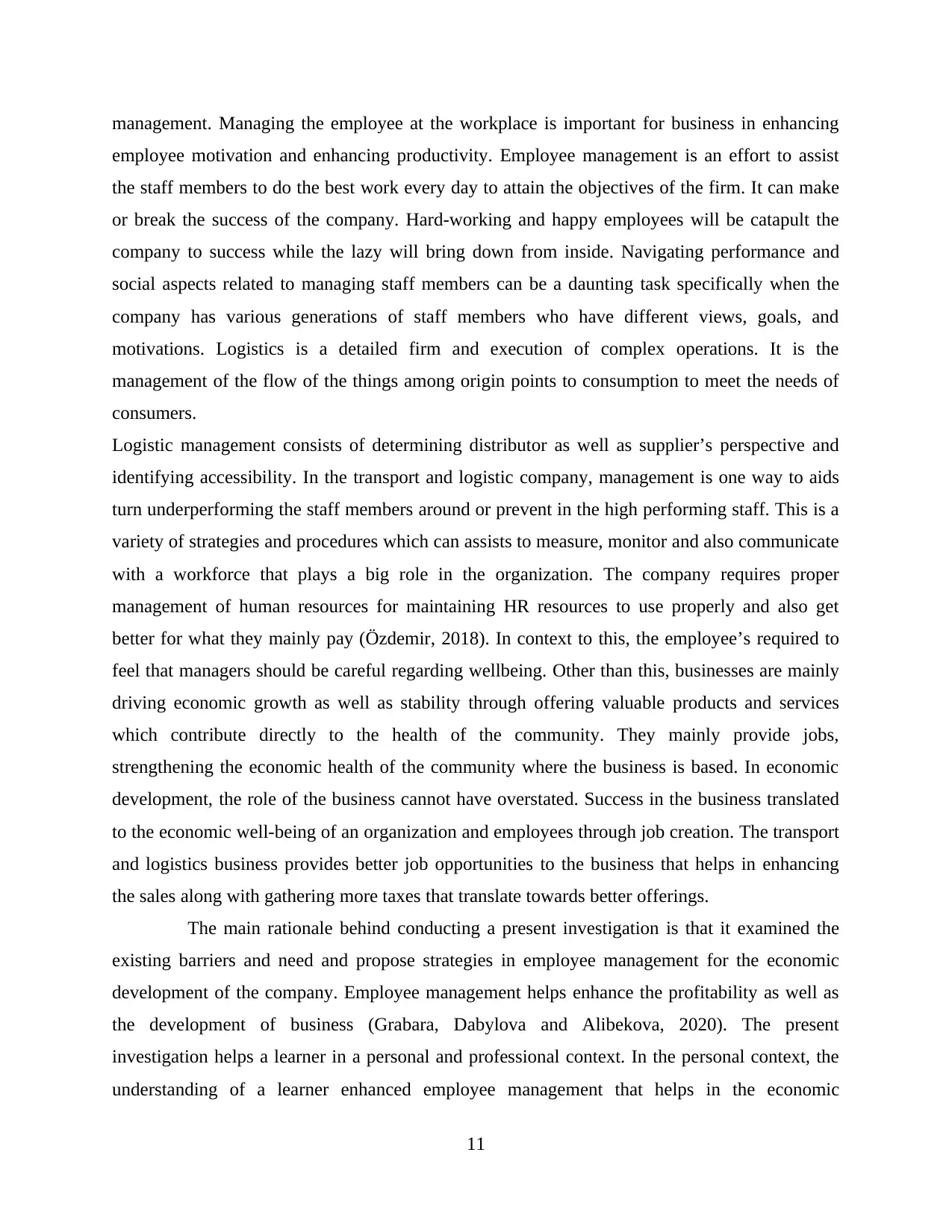
management. Managing the employee at the workplace is important for business in enhancing
employee motivation and enhancing productivity. Employee management is an effort to assist
the staff members to do the best work every day to attain the objectives of the firm. It can make
or break the success of the company. Hard-working and happy employees will be catapult the
company to success while the lazy will bring down from inside. Navigating performance and
social aspects related to managing staff members can be a daunting task specifically when the
company has various generations of staff members who have different views, goals, and
motivations. Logistics is a detailed firm and execution of complex operations. It is the
management of the flow of the things among origin points to consumption to meet the needs of
consumers.
Logistic management consists of determining distributor as well as supplier’s perspective and
identifying accessibility. In the transport and logistic company, management is one way to aids
turn underperforming the staff members around or prevent in the high performing staff. This is a
variety of strategies and procedures which can assists to measure, monitor and also communicate
with a workforce that plays a big role in the organization. The company requires proper
management of human resources for maintaining HR resources to use properly and also get
better for what they mainly pay (Özdemir, 2018). In context to this, the employee’s required to
feel that managers should be careful regarding wellbeing. Other than this, businesses are mainly
driving economic growth as well as stability through offering valuable products and services
which contribute directly to the health of the community. They mainly provide jobs,
strengthening the economic health of the community where the business is based. In economic
development, the role of the business cannot have overstated. Success in the business translated
to the economic well-being of an organization and employees through job creation. The transport
and logistics business provides better job opportunities to the business that helps in enhancing
the sales along with gathering more taxes that translate towards better offerings.
The main rationale behind conducting a present investigation is that it examined the
existing barriers and need and propose strategies in employee management for the economic
development of the company. Employee management helps enhance the profitability as well as
the development of business (Grabara, Dabylova and Alibekova, 2020). The present
investigation helps a learner in a personal and professional context. In the personal context, the
understanding of a learner enhanced employee management that helps in the economic
11
employee motivation and enhancing productivity. Employee management is an effort to assist
the staff members to do the best work every day to attain the objectives of the firm. It can make
or break the success of the company. Hard-working and happy employees will be catapult the
company to success while the lazy will bring down from inside. Navigating performance and
social aspects related to managing staff members can be a daunting task specifically when the
company has various generations of staff members who have different views, goals, and
motivations. Logistics is a detailed firm and execution of complex operations. It is the
management of the flow of the things among origin points to consumption to meet the needs of
consumers.
Logistic management consists of determining distributor as well as supplier’s perspective and
identifying accessibility. In the transport and logistic company, management is one way to aids
turn underperforming the staff members around or prevent in the high performing staff. This is a
variety of strategies and procedures which can assists to measure, monitor and also communicate
with a workforce that plays a big role in the organization. The company requires proper
management of human resources for maintaining HR resources to use properly and also get
better for what they mainly pay (Özdemir, 2018). In context to this, the employee’s required to
feel that managers should be careful regarding wellbeing. Other than this, businesses are mainly
driving economic growth as well as stability through offering valuable products and services
which contribute directly to the health of the community. They mainly provide jobs,
strengthening the economic health of the community where the business is based. In economic
development, the role of the business cannot have overstated. Success in the business translated
to the economic well-being of an organization and employees through job creation. The transport
and logistics business provides better job opportunities to the business that helps in enhancing
the sales along with gathering more taxes that translate towards better offerings.
The main rationale behind conducting a present investigation is that it examined the
existing barriers and need and propose strategies in employee management for the economic
development of the company. Employee management helps enhance the profitability as well as
the development of business (Grabara, Dabylova and Alibekova, 2020). The present
investigation helps a learner in a personal and professional context. In the personal context, the
understanding of a learner enhanced employee management that helps in the economic
11
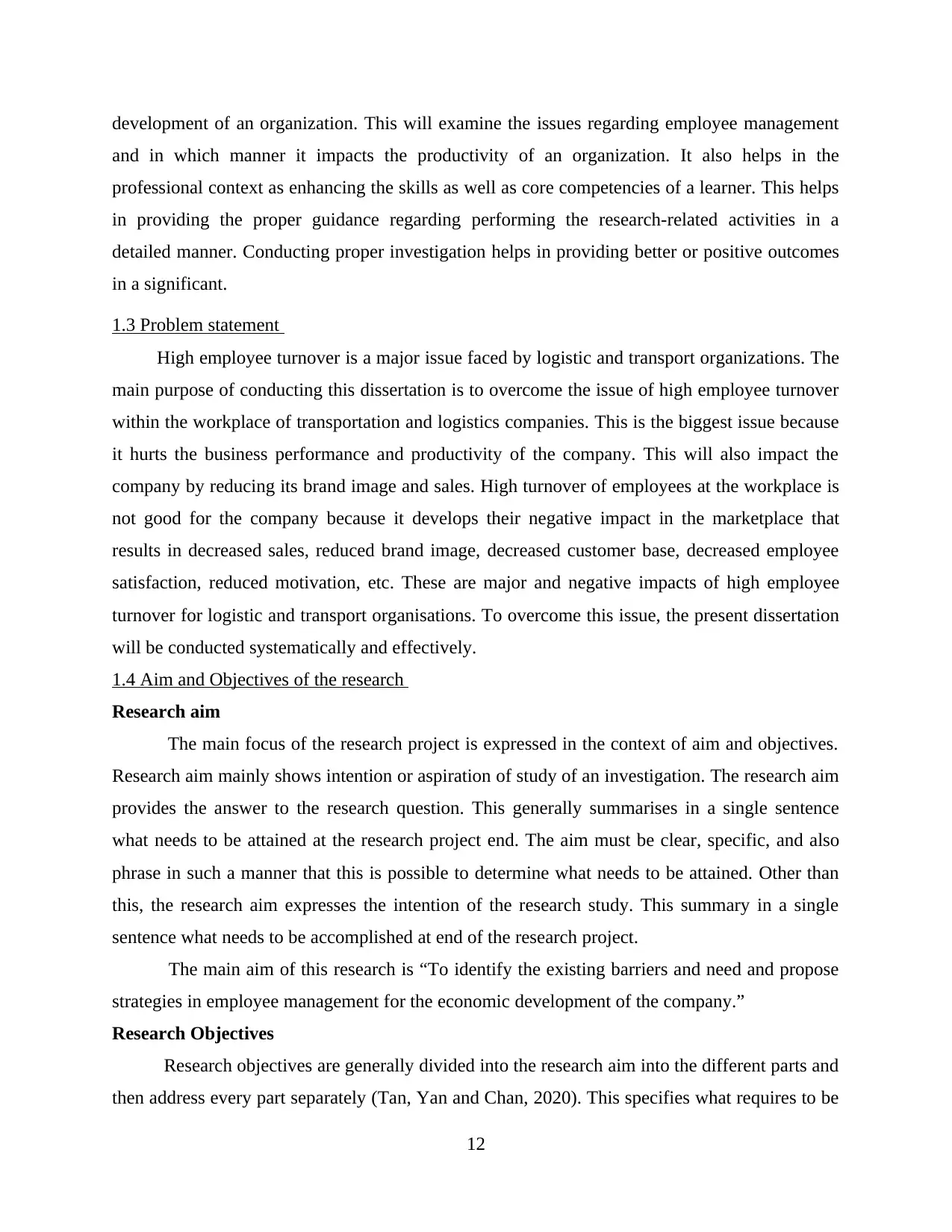
development of an organization. This will examine the issues regarding employee management
and in which manner it impacts the productivity of an organization. It also helps in the
professional context as enhancing the skills as well as core competencies of a learner. This helps
in providing the proper guidance regarding performing the research-related activities in a
detailed manner. Conducting proper investigation helps in providing better or positive outcomes
in a significant.
1.3 Problem statement
High employee turnover is a major issue faced by logistic and transport organizations. The
main purpose of conducting this dissertation is to overcome the issue of high employee turnover
within the workplace of transportation and logistics companies. This is the biggest issue because
it hurts the business performance and productivity of the company. This will also impact the
company by reducing its brand image and sales. High turnover of employees at the workplace is
not good for the company because it develops their negative impact in the marketplace that
results in decreased sales, reduced brand image, decreased customer base, decreased employee
satisfaction, reduced motivation, etc. These are major and negative impacts of high employee
turnover for logistic and transport organisations. To overcome this issue, the present dissertation
will be conducted systematically and effectively.
1.4 Aim and Objectives of the research
Research aim
The main focus of the research project is expressed in the context of aim and objectives.
Research aim mainly shows intention or aspiration of study of an investigation. The research aim
provides the answer to the research question. This generally summarises in a single sentence
what needs to be attained at the research project end. The aim must be clear, specific, and also
phrase in such a manner that this is possible to determine what needs to be attained. Other than
this, the research aim expresses the intention of the research study. This summary in a single
sentence what needs to be accomplished at end of the research project.
The main aim of this research is “To identify the existing barriers and need and propose
strategies in employee management for the economic development of the company.”
Research Objectives
Research objectives are generally divided into the research aim into the different parts and
then address every part separately (Tan, Yan and Chan, 2020). This specifies what requires to be
12
and in which manner it impacts the productivity of an organization. It also helps in the
professional context as enhancing the skills as well as core competencies of a learner. This helps
in providing the proper guidance regarding performing the research-related activities in a
detailed manner. Conducting proper investigation helps in providing better or positive outcomes
in a significant.
1.3 Problem statement
High employee turnover is a major issue faced by logistic and transport organizations. The
main purpose of conducting this dissertation is to overcome the issue of high employee turnover
within the workplace of transportation and logistics companies. This is the biggest issue because
it hurts the business performance and productivity of the company. This will also impact the
company by reducing its brand image and sales. High turnover of employees at the workplace is
not good for the company because it develops their negative impact in the marketplace that
results in decreased sales, reduced brand image, decreased customer base, decreased employee
satisfaction, reduced motivation, etc. These are major and negative impacts of high employee
turnover for logistic and transport organisations. To overcome this issue, the present dissertation
will be conducted systematically and effectively.
1.4 Aim and Objectives of the research
Research aim
The main focus of the research project is expressed in the context of aim and objectives.
Research aim mainly shows intention or aspiration of study of an investigation. The research aim
provides the answer to the research question. This generally summarises in a single sentence
what needs to be attained at the research project end. The aim must be clear, specific, and also
phrase in such a manner that this is possible to determine what needs to be attained. Other than
this, the research aim expresses the intention of the research study. This summary in a single
sentence what needs to be accomplished at end of the research project.
The main aim of this research is “To identify the existing barriers and need and propose
strategies in employee management for the economic development of the company.”
Research Objectives
Research objectives are generally divided into the research aim into the different parts and
then address every part separately (Tan, Yan and Chan, 2020). This specifies what requires to be
12
⊘ This is a preview!⊘
Do you want full access?
Subscribe today to unlock all pages.

Trusted by 1+ million students worldwide
1 out of 78
Related Documents
Your All-in-One AI-Powered Toolkit for Academic Success.
+13062052269
info@desklib.com
Available 24*7 on WhatsApp / Email
![[object Object]](/_next/static/media/star-bottom.7253800d.svg)
Unlock your academic potential
Copyright © 2020–2025 A2Z Services. All Rights Reserved. Developed and managed by ZUCOL.





